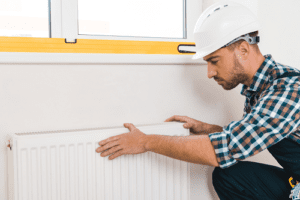With a significant portion of practically every business’s budget going directly to energy costs every year, the fact that most companies are constantly on a quest to improve efficiency should come as no surprise. Heating and cooling are essential for employee and customer comfort; after all, they’re not optional by any measure. However, that does not mean that your commercial building should face exorbitant energy charges every year. Whether your concern is with reducing the company’s carbon footprint or with reducing utility expenditures to free up room in the operating budget, it’s worth your time to investigate every solution. Many businesses feel similarly, which leads them to the discovery of the growing number of alternatives to traditional furnaces, such as commercial radiant heating systems.
Eschewing ducted forced air furnaces can seem like a drastic move at first, but radiant systems can offer a range of essential benefits to their users. Though most easily installed during the construction phase of a building, renovations and retrofits can allow for different types of radiant systems to begin heating your business. First, though, developing a fundamental understanding of how these setups work is the most important step.
What Are Commercial Radiant Heating Systems in the First Place?
 To use the simplest definition first, radiant heating is any system which warms a room not through the direct introduction of air heated by a furnace, but by heating the air directly in the room. The oldest and most iconic version of radiant heating is an old-style radiator, which received hot water from a central boiler pumped into its metal housing. The hot water would heat the metal, and both would “radiate” their heat into the room through the air — thus the name “radiant.”
To use the simplest definition first, radiant heating is any system which warms a room not through the direct introduction of air heated by a furnace, but by heating the air directly in the room. The oldest and most iconic version of radiant heating is an old-style radiator, which received hot water from a central boiler pumped into its metal housing. The hot water would heat the metal, and both would “radiate” their heat into the room through the air — thus the name “radiant.”
Modern systems take the same principle but make it far more efficient. Today, tubing made of special durable plastic is placed beneath flooring or directly in concrete slabs. These tubes connect to a pump, which draws water or a particular medium (such as glycol) heated to a high temperature. Circulating through these tubes, the liquid releases its heat up through the floor, which in turn warms the air. All the occupants in the room will feel warmer in general as a result. Some systems use electric heating pads rather than tubes, but these are less common on the commercial scale.
Scaling Radiant Systems for Commercial Use
Once primarily used in home installations, radiant systems powerful enough for commercial spaces continue to grow in popularity as building owners consider their HVAC options. The principle remains the same, but rooms may receive much more plastic tubing beneath the floor to develop and maintain the required temperature. Commercial users of radiant heating may need some time to adjust to the difference in operation; you may expect to feel warm immediately, but radiant heating works best over time. Before you notice, though, you’ll recognize that the space does feel comfortable — you simply won’t have hot air blowing directly at you.
Due to the extensive work involved in the initial installation, retrofitting these systems into existing flooring pose more of a challenge than a purpose-built radiant system. Therefore, it is best to consider installing them whenever work on the flooring will take place. Otherwise, it may prove disruptive to the daily flow of work. When added during initial construction, however, you can often have radiant systems ready for use as soon as construction ends, and the building opens to the public.
The Key Benefits to Radiant Heating
With commercial radiant heating systems already working at scale in many buildings, why should others consider undertaking a project related to it themselves? A look at its advantages makes the answer clear. A radiant system:
- Delivers better energy efficiency than running a gas-fired furnace all winter.
- Rarely requires maintenance due to the sealed nature of the system, typically intended to last for many years.
- Delivers a more consistent temperature in the room over time, as opposed to the fluctuations caused by the on and off cycling of the furnace.
- Runs silently and doesn’t have any impact on air quality.
- Keeps floors dry in areas that can grow wet, such as from rain or melted snow tracked in by visitors.
Exploring Your Options with a Licensed Contractor
At a time when everyone wants new ways to save on energy without losing functionality, good solutions are few and far between. However, commercial radiant heating systems show real promise, especially when paired with efforts to incorporate renewable energy sources into the building’s utility profile. With gentle, even heat that permeates rooms and provides a consistently pleasant experience, there are many commercial applications for this technology. From hospitals to restaurants, these solutions can offer a viable alternative to more traditional furnaces. Connect with a licensed and experienced HVAC technician in your area to discuss what options you have at your disposal.

